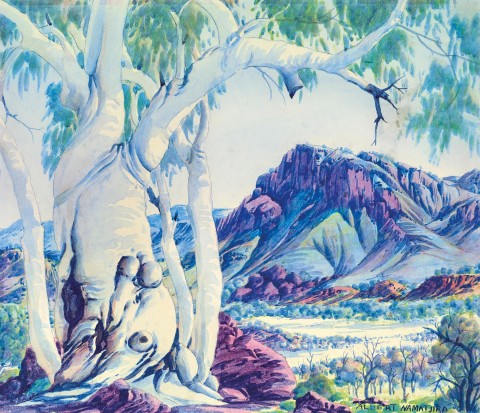RIVER GUM NEAR BITTER SPRINGS GORGE
ALBERT NAMATJIRA
watercolour on paper
33.5 x 38.5 cm image
36.5 x 41.0 cm sheet
signed lower right: ALBERT NAMATJIRA
signed verso: Albert Namatjira
bears inscription with title verso: 45 Gns / River Gum Near Bitter Springs Gorge / Arltunga, NT
Ranald Chandler AM, Queensland
Private collection, Sydney, acquired from the above in 1989
‘… Many years ago an Aboriginal man from central Australia, Albert Namatjira, became very famous as a painter. Using Western watercolour techniques he painted many landscapes. But what non-aboriginal people didn’t understand, or chose not to understand, was that he was painting his country, the land of the Arrernte people. He was demonstrating to the rest of the world the living title held by his people to the lands they had been on for thousands of years’.1
Although an accomplished craftsman producing poker work-decorated woomeras, boomerangs and wooden plaques, it was not until viewing an exhibition of watercolours by Victorian artists Rex Battarbee and John Gardner at the Hermannsburg Mission in 1934, that Albert Namatjira truly embarked upon painting as a profession. Immediately captivated by the medium, he pleaded to be taught watercolour techniques and eventually Battarbee agreed to Namatjira accompanying him on two month-long expeditions in 1936 through the Palm Valley and MacDonnell Range areas. Thus began the cultural exchange that was to be an important aspect of their enduring relationship: Battarbee instructed Namatjira about the technique of watercolour painting, and in turn, Namatjira imparted his sacred knowledge about the subjects they were to paint – namely, the land of the Western Aranda (Arrernte) people, his ‘Dreaming’ place. Indeed, so impressive was Namatjira’s skill that Battarbee noted after only a brief period, ‘I felt he had done so well that he had no more to learn from me about colour’.2 Success and recognition soon followed and Namatjira was launched onto the international stage as a cultural ‘icon’, widely acclaimed and admired for his innovative, vibrantly coloured desert landscapes that encouraged ‘new ways of seeing the Centre.’ Today Namatjira’s iconic watercolours have become synonymous with our vision of the Australian outback and indeed, he is universally heralded as the pioneer of contemporary Indigenous art in Australia – a legacy honoured in more recent years by the publication of three biographies, and the organisation of three major exhibitions by public galleries (including a retrospective at the National Gallery of Australia to celebrate the centenary of his birth in 2002).
Like many of Namatjira’s finest works, River Gum near Bitter Springs Gorge, evokes the artist’s distinctive compositional type with his much-loved, luminous white ghost gum dominating the foreground, silhouetted against a dramatic, brilliantly coloured backdrop of distant mountain ranges. Balanced on the left side of the composition and reaching beyond the depicted scene, the majestic gum plays a pivotal role not only as a framing device but also as a point of entry into the picture plane. More fundamentally perhaps, the signature cropped tree motif creates a tangible sense of being present in the landscape, of participating alongside the artist in seeing and identifying with the land – thus imbuing the work with an unmistakable intimacy, notwithstanding the panoramic view and monolithic forms. For while immortalising an ostensibly Western-style topographical view of the Central Australian landscape in all its myriad moods and rich textures, such depictions ultimately resonated with important personal symbolism for Namatjira as statements of belonging – coded expressions embodying the memory and sacred knowledge of a traditional ancestral site, his ‘dreaming’ or totem place.
1. Galarrwuy Yunupingu quoted in ‘The black/white conflict’ in Caruana, W. (ed.), Windows on the Dreaming, Australian National Gallery, Canberra and Ellsyd Press, Sydney, 1989, p. 14
2. Morphy, H., Aboriginal Art, Phaidon Press, London, 1998, p. 268
VERONICA ANGELATOS
